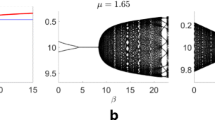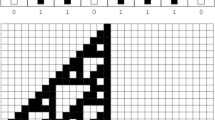Abstract
We use game theory and Santa Fe Artificial Stock Market, anagent-based model of an evolving stock market, to study theoptimal frequency for traders to revise their market forecastingrules. We discover two things: There is a unique strategic Nashequilibrium in the game of choosing forecast revision rates, andthis equilibrium is sub-optimal in the sense that traders'earnings are not maximized an the market is inefficient. Thisstrategic equilibrium is due to an analogue of the prisoner'sdilemma; the optimal global state is unstable because eachtrader has too much incentive to `defect' and use forecastingrules that pull the market into thesub-optimal equilibrium.
Similar content being viewed by others
References
Acar, E. and Satchell, S. (1997). Advanced Trading Rules, Butterworth-Heineann: Woburn.
Arthur, W.B. (1988). Self-reinforcing mechanisms in economics. In: P.W. Anderson, K.J. Arrow and D. Pines (eds.). The Economy as an Evolving, Complex System I: Proceedings of the Evolutionary Paths of the Global Economy Workshop, Addison-Wesley, Redwood City.
Arthur, W.B. (1989). Positive feedbacks in the economy, it Scientific American (February). 92–99.
Arthur, W.B. (1992). On learning and adaptation in the economy, Working Paper 92-07-038, Santa Fe Institute, Sante Fe NM.
Arthur, W.B., Holland, J.H., LeBaron, B., Palmer, R. and Tayler, P. (1997). Asset pricing under endogenous expectations in an artificial stock market. In:W.B. Arthur, D. Lane and S.N. Durlauf (eds.). The Economy as an Evolving, Complex System II, Menlo-Park: Addison-Wesley.
Axelrod, R. (1984). The Evolution of Cooperation, New York: Basci Books.
Bierman, S.H. and Fernandez, L. (1993). Game Theory with Economic Applications, Redwood City: Addison-Wesley.
Bra, M. (1981). Futures trading, rational expectations, and efficient markets hypothesis, Econometrica 49, 575–596.
Brock, W., Lakonishok, J. and LeBaron, B. (1992). Simple technical trading rules and the stochastic properties of stock returns, Journal of Finance 47, 1731–1764.
Campbell, J.Y. and Lo, A. (1997). The Econometrics of Financial Markets, Princeton: Princeton University Press.
Chancellor, E. (1999). Devil Take the Hindmost: History of Financial Speculation, New York, Farrar Straus and Giroux.
Cootner, P. (1967). The Random Character of Stock Market Prices, Cambridge: MIT Press.
De Bondt, W.F.M. and Thaler, R.H. (1995). Financial decision making in markets and firms:A behavioral perspective. In: R. Jarrow et al. (eds.), Handbooks in Operations Research and Management Science. Vol. 9, Elsevier Science.
De Long, J.B., Schleifer, A., Summers, L.H. and Waldmann, J. (1990a). Positive feedback and destabilising rational speculation, Journal of Finance 45, 379–395.
De Long, J.B., Schleifer, A., Summers, L.H. and Waldmann, J. (1990b). Noise trader risk in financial markets, Journal of Political Economy 98, 703–738.
De Long, J.B., Schleifer, A., Summers, L.H. and Waldmann, J. (1991). The survival of noise traders in financial markets, Journal of Business 64, 1–18.
Fama, E.F. (1970). Efficient capital markets: A review of theory and empirical work, Journal of Finance bf 25, 383–420.
Farmer, R.A. (1993). The Macroeconomics of Self-Fulfilling Prophecies, Cambridge: MIT Press.
Farmer, J.D. (1998). Market force, ecology and evolution. Working Paper 98-12-116, Santa Fe Institute, Santa Fe NM.
Frankel, J.A. and Froot, K.A. (1990). Chartists, fundamentalists, and trading in the foreign exchange market, AEA Papers and Proceedings 80, 181–185.
Joshi, S. and Bedau, M.A. (1998). An explanation of generic behavior in an evolving financial market. In: R. Standish, B. Henry, S Watt, R. Marks, R. Stocker, D. Green, S. Keen and T. Bossomaier (eds.), Complex Systems' 98, Complexity. Between the Ecos: From Ecology to Economics, Complexity Online: Sydney, pp. 326–332.
Joshi, S., Parker, J. and Bedau, M.A. (1998). Technical trading creates a prisoner's dilemma: Results from an agent-based model, Working Paper No. 98-12-115, Santa Fe Institute, Santa Fe NM, to appear in the proceedings of Conference on Computational Finance 1999.
Keim, D.B. and Madhaven, A. (1995). Anatomy of the trading process: Empirical evidence of the behavior of institutional traders. Journal of Financial Economics 37, 371–398.
Keynes, J.M. (1936). The General Theory of Employment, Interest and Money, New York: Harcurt, Brace. Reprinted in 1973: New York: W.W. Norton.
Kirman, A. (1991). Epidemics of opinion and speculative bubbles in financial markets. In: M. Taylor (ed.), Money and Financial Markets, London: Macmillan.
Kurtz, M. (1994). On the structure and diversity of rational beliefs, Economics Theory 4, 877–900.
LeBaron, B., Arthur, W.B. and Palmer, R. (1998). Time series properties of an artificial stock market. Journal of Economic Dynamics and Control, forthcoming.
LeBaron, B. (1997). Technical trading rules and regimes shifts in foreign exchange markets. In: E. Acar and S. Satchell (eds.), Advanced Trading Rules, Woburn: Butterworth-Heinemann.
Lindgren, K. (1998). Coevolution of strategies in N-person prisoners dilemma games, presented at the workshop. Evolutionary Dynamics Exploring the Interplay of Selection, Neutrality, Accident, and Function. Santa Fe Institute, Santa Fe, NM, October 5–9, 1998.
Lo, A.W. and Mackinlay, A.C. (1999). A Non-Random Walk Down Wall Street, Princeton: Princeton University Press.
Malkiel, B. (1992). Efficient market hypothesis. In: P. Newman, M. Milgate and J. Eatwell (eds.), New Palgrave Dictionary of Money and Finance. London: Macmillan Press Limited.
Marengo, L. and Tordjman, H. (1995). Speculation, heterogeneity, and learning: A model of exchange rate dynamics. Working Paper WP-95-17, IIASA.
Palmer, R.G., Arthur, W.B., Holland, J.H., LeBaron, B. and Tayler, P. (1994). Artificial economic life: a simple model of a stock market. Physica D 75, 264–274.
Riekc, C. (1994). Evolutionary simulation of asset trading strategies. In: E. Hillenbrand and J. Stender (eds.), Many Agent Simulation and Artificial Life. Washington DC: IOS Press.
Samuelson, P. (1965). Proof that properly anticipated prices fluctuate randomly. ndustrial Management Review 6, 41–49.
Sargent, T.J. (1993). Bounded Rationality and Macroeconomics. Clarendon Press: Oxford.
Shleifer, A. and Summers, L.H. (1990). The noise trader approach to finance. Journal of Economic Perspectives 4, 19–33.
Schwager, J.D. (1995). Technical Analysis. New York: John Wiley and Sons.
Shiller, R. (1989). Market Volatility. Cambridge: MIT Press.
Soros, G. (1987). The Alchemy of Finance. New York: Simon and Schuster.
Soros, G. (1994). The Theory of Reflexivity. New York: Soros Fund Management.
Summers, L.H. (1986). Does the market rationally reflect fundamental values? Journal of Finance 46, 591–601.
Youssefmir, M., Huberman, B. and Hogg, T. (1998). Bubbles and market crashes. Computational Economics 21, 97–114.
Author information
Authors and Affiliations
Rights and permissions
About this article
Cite this article
Joshi, S., Parker, J. & Bedau, M.A. Financial Markets can be at Sub-Optimal Equilibria. Computational Economics 19, 5–23 (2002). https://doi.org/10.1023/A:1014988805326
Issue Date:
DOI: https://doi.org/10.1023/A:1014988805326




